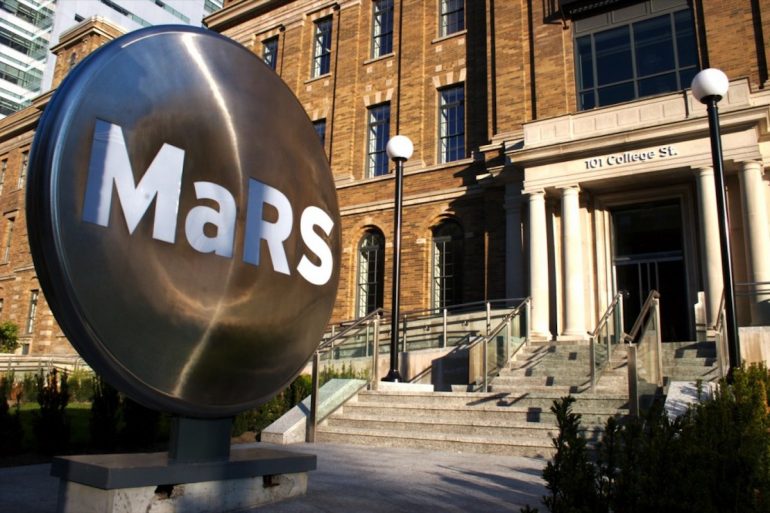As its new CEO continues to overhaul MaRS Discovery District’s operations, the Toronto-based innovation hub has made additional layoffs and revamped its advisory model.
After laying off 20 staff members in June 2024, predominantly at the leadership level, MaRS told BetaKit it had cut a further 11 people from its team, while moving eight of its advisors from employees to contract positions.
“Rather than thinking you’re three lines of business, you’re one business.”
These latest reductions bring MaRS Discovery District’s total headcount to 101 employees.
Including MaRS Investment Accelerator Fund (IAF) and its real estate arm, the headcount across MaRS as a whole sits at 153.
In an interview with BetaKit, MaRS CEO Alison Nankivell said the latest reductions are part of the innovation hub’s continued effort to reset its business model, which includes a target to achieve a 50/50 split between public and private funding “in the next few years.”
“Some of the things and activities we were doing made us overly dependent on government revenues,” Nankivell added. “And as we were moving back to having just core government support for the sort of core programs we deliver … we needed to rethink our business model.”
Founded in 2000 by biotech entrepreneur John Evans, MaRS was established to accelerate the development of knowledge-based businesses in Canada, with an initial focus on healthtech and biosciences. Since then, the organization has broadened its reach to support startups across cleantech, software, and artificial intelligence, among other initiatives.
In June, BetaKit reported that MaRS made staffing reductions as the hub sought to get back to its original vision.

Nankivell, who joined MaRS as CEO in March, told BetaKit that vision includes an improved integration of the three “legs” of MaRS, which includes MaRS IAF, its real estate arm, and the Discovery District, which provides its innovation programming and were the source of today’s staff reductions (in legal, IT, and event roles).
While IAF, the Discovery District, and the real estate arm all fall under the MaRS umbrella, they each have unique funding sources and models. The real estate arm, for instance, functions as an independent profit centre with its own budget and allowances to reinvest profits back into the Discovery District. Like IAF, Nankivell called it “totally self-sufficient.”
However, despite their shared ties, Nankivell noted that these divisions often functioned in isolation from one another prior to her tenure. The CEO attributed the operational silos to the complexities of each division’s financing.
“Rather than thinking you’re three lines of business, you’re one business,” Nankivell said, noting that the revised approach will require all divisions in the same room to make decisions and pool resources.
“We are always thinking of the respective elements of strengths and skill sets that sit in each of those legs of that three-legged stool to think about what the offering can be and who can do what,” she added.
Under a new integrated platform, MaRS is also looking to double down on its sector focus on cleantech and healthtech, which Nankivell noted “makes perfect sense, given our facilities are 70 percent wet lab space. We have a depth of clientele here and we sit in the largest biotech hub in Canada.”
MaRS is also exploring new revenue streams, which may include leveraging its international profile as a revenue driver. The hub already has a partnership with Innovate UK to offer a cooperative incubator. “We give [international companies] a sense of orientation, but we also introduce them to our community, which means that we’re cultivating partnerships between U.K. startups and Canadian startups in areas like healthcare and AI,” she added.
Nankivell’s vision for MaRS also includes reducing the nonprofit’s reliance on public money. The CEO said roughly two-thirds of the Discovery District’s revenue comes from provincial and federal grants. She is now targeting a 50/50 split between public and private funding.
“That just makes sense, because, you know, you build a much more financially resilient model when you have multiple sources of revenue,” Nankivell added.
In March, the Discovery District concluded a two-year extension of its funding agreement with the Ontario government, during which the province contributed $10 million each year. Nankivell confirmed to BetaKit that the funding agreement was renewed earlier this year, but noted she is not aware whether or not the new agreement included a reduction in provincial funding.
According to MaRS’ most recent audited financial statements, the organization saw approximately $29 million CAD in revenue, of which only $10 million CAD came from non-government sources, a decline of 10 percent from the year prior and 65 percent from 2019. A MaRS spokesperson told BetaKit that with its recent staff reductions and strategic realignment to save the innovation hub more than $5 million in operating costs, to a target of $22 million annually.
With files from Douglas Soltys, Isabelle Kirkwood, and Madison McLauchlan.


